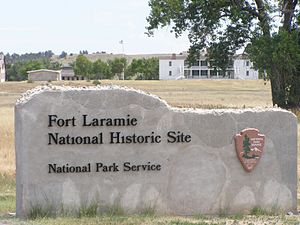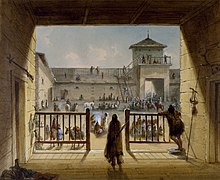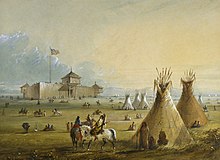Fort Laramie National Historic Site
| Fort Laramie National Historic Site | |
|---|---|
 |
|
| Location | Goshen County, Wyoming, USA |
| Nearest city | Torrington, Wyoming |
| Coordinates | 42°12′33″N 104°32′9.1″W / 42.20917°N 104.535861°WCoordinates: 42°12′33″N 104°32′9.1″W / 42.20917°N 104.535861°W |
| Area | 833 acres (337 ha) |
| Established | March 4, 1931 |
| Visitors | 46,455 (in 2005) |
| Governing body | National Park Service |
| Website | |
|
Fort Laramie National Historic Site
|
|
| Nearest city | Fort Laramie, Wyoming |
| Area | 536 acres (217 ha)[2] |
| Built | 1834 |
| Built by | US Army Corps of Engineers |
| Architect | US Army Corps of Engineers |
| Architectural style | Lime grout construction |
| NRHP Reference # | 66000755[1] |
| Added to NRHP | October 15, 1966 |
Fort Laramie (founded as Fort William and then known for a while as Fort John) was a significant 19th century trading post and diplomatic site located at the confluence of the Laramie River and the North Platte River in the upper Platte River Valley in the eastern part of the U.S. state of Wyoming. It was founded in the 1830s to service the overland fur trade during the middle 19th century. It sat at the bottom of the long climb leading to the best and lowest crossing point at South Pass into western descending valleys and so was a primary stopping point on the Oregon Trail. Along with Bent's Fort on the Arkansas River, the trading post and its supporting industries and businesses were the most significant economic hub of commerce in the region.
Fort William was a private fur trading post founded by William Sublette in 1834. In 1841 it was purchased by the American Fur Company and renamed Fort John. In 1849 it was purchased and its operations were taken over by the United States Army to protect the many wagon trains of migrant travelers on the Oregon Trail, and hence the subsidiary co-located northern emigrant trails which split off further west such as the California and Mormon trails. The middle reaches of the Mormon trail stayed on the north banks of the Platte and North Platte River and merged with the other emigrant trails heading west over the continental divide from Fort John-Laramie. The name Fort Laramie came into gradual use, likely as a convenient shortening of "Fort John at the Laramie River".
The remaining structures are preserved as the Fort Laramie National Historic Site by the National Park Service.
Contents
History[edit]
Name[edit]
In 1815 or 1816, Jacques La Ramee and a small group of fellow trappers settled in the area where Fort Laramie would later be located. He went out alone to trap in 1819 or 1820 and was never seen again. Arapahoe Indians were accused of killing La Ramie and putting his body in a beaver dam. The river was named “Laramie” in his honor, and the name would later be given to the Laramie Mountains, the fort, and the towns of Laramie, Wyoming and Fort Laramie, Wyoming.[3][4]
The fur trade[edit]
The original fort was constructed in the 1830s— probably in 1833–1834 after William Sublette recovered from the wounds received after the Rendezvous of 1832 in the Battle of Pierre's Hole — during the boom period of the overland fur trade and situated near the rivers junction so the fort commanded a broad plain with water on two sides forming in effect, a partial natural moat. The nearby confluence of the North Platte's waters from two smaller, safer, noticeably more shallow streams to cross in that era without bridges made the location a convenient destination for any travelers on what later became the northern overland emigrant trails following the North Platte River west from Nebraska. With the opening of the Mormon Trail on the north bank of the Platte and North Platte, the fort served as a trail merge junction for west bound travelers and acted as a common intermediary trailhead anchoring one way-point roughly a quarter of the way to either California or Oregon on the famous Oregon Trail. To the west, the common trail leaving Fort John-Laramie later spins-off the south jogging Mormon and California trails further west, and the road to the Rogue River Valley while the main trail transits northwest to Oregon's Willamette Valley and Oregon City. One of the early principal owner-trappers was William Sublette, and the fort was therefore called Fort William.[5] for a period of time until it was sold to the American Fur Company in 1841. It was later named Fort John after John B. Sarpy, a partner in the American Fur Company which acquired the property, and that was the name given the destination during the early days of the surge in migration beginning in the political settlements with Mexico and Great Britain in 1846.[6] The 1846 treaties established new desirable stable western territories just after viable routes west had become well published. By the time the westward migration by occasional wagon trains along the Oregon Trail became regular annual flood of migrants, the U.S. Army had become tenants in the fort as well. The fort was located along the northward running Laramie River just south of its mouth out-letting onto the North Platte River. The fort's site is located on the opposite bank of the location of the town of Fort Laramie, Wyoming, and both were later renamed to match the rivers eponym.

Geographically the site is situated just east of the steeper, much more challenging, steadily climbing foothills terrain to the west (sometimes called "High Plains") that ascends to the east side of the Rocky Mountains proper. The ascent beginning there was one of only a few roadways capable of navigation by wagons piercing the Continental divide and reaching the west slopes of that range along the network of river valleys connecting to the far west via South Pass near the head waters of the North Platte. The strategic site on the eastern plains offered large grazing areas to rest up draft animals before the ordeal of the long climbing trails and also places for people to set up camps, do laundry, and heal before beginning anew the rigors of the westward trail.
In 1845 the nearby Fort Bernard was established about 8 miles (13 km) east farther down the North Platte River in hopes of cutting into the growing Emigrant Trail trade with western bound wagon trains. This much smaller fort undersold the Laramie trading operation, and did excellent business, as well as offered a connection south via a crude mule-train road to the Santa Fe Trail via Colorado. Fortunately for Fort Laramie, Fort Bernard burnt down in 1866, and was never rebuilt.[7] Only a few years later the transcontinental railway joined the two American sea coasts and the heyday of long perilous overland travel along the Emigrant Trails by half-a-million a year began to decline.
Frontier army post[edit]

The fort was purchased from Bruce Husband, a member of the American Fur Company, for $4,000 in June 1849 by U.S. Army Lt. Daniel P. Woodbury on behalf of the United States Government. Three companies of cavalry arrived at the fort that same month, and Company ‘G’, 6th Infantry, which was the post’s permanent garrison for many years, arrived on August 12, 1849.[5]
The fort was taken over by the Army largely to protect and supply emigrants along the emigrant trails. In 1851, the first Treaty of Fort Laramie was signed, resulting in relatively peaceful relations between the whites and the Native Americans during the 1850s, though troops from the fort made up the small force that was killed during the Grattan massacre of 1854 under the command of Second Lieutenant John Lawrence Grattan. During the increasing strife of the 1860s, the fort took on a more military posture.
Fort Laramie was never seriously threatened by Indian attacks during the quarter-century of intermittent warfare sparked by the Grattan massacre. However, a number of civilians were killed in the immediate area and their property destroyed or stolen during this period of hostilities on the plains. The last known death occurred in March 1877 on the Big Bitter Cottonwood Creek.[8]
The earliest surviving photograph of Fort Laramie, taken in 1858 by Samuel C. Mills, shows the remains of the old adobe walled fur trade fort (Fort John) flanked by a cluster of scattered wood and adobe buildings around the parade grounds.
The Civil War, 1861-65[edit]
With the outbreak of the American Civil War in 1861, the troops at Fort Laramie were withdrawn to fight the Confederate States Army in the east. To take their place, a series of volunteer regiments soon arrived at Fort Laramie, including the 11th Ohio Cavalry, serving until they were mustered out in 1866. Between October 1864 and October 1866 at least two companies from various units of "Galvanized Yankees" (Confederate prisoners of war recruited in the Union Army) were stationed at Fort Laramie.
The Bozeman War, 1866-68[edit]
On Christmas night in 1866, John "Portuguese" Phillips ended his historic horseback ride at Fort Laramie after riding 236 miles (380 km) from the Powder River. "Lt. William J. Fetterman's entire unit had been killed in a fight with the Sioux under Red Cloud," and Phillips arrived at Fort Laramie to summon help for Fort Phil Kearny. Legend maintains that Phillips' thoroughbred horse dropped dead upon arriving at the fort, though it is unclear as to whether Phillips kept the same mount for the entire ride. "Whatever the particulars of his ride, Phillips did cross hostile Indian country, and most of the journey took place during a brutal Wyoming blizzard.
In the late 1860s, the fort was the primary staging ground for the United States in the Powder River Country during Red Cloud's War. The resultant peace agreement reached in 1868 was the second Treaty of Fort Laramie.
Great Sioux War of 1876-77[edit]
The discovery of gold in the Black Hills touched off another period of conflict with the Lakota and Northern Cheyenne during the Great Sioux War of 1876-77. During this period of conflicts, Fort Laramie served as a major staging point for supplies and troops.
Final years[edit]
After the completion of the transcontinental railroad, the fort's importance gradually decreased as fewer wagon trains were formed to take the various trails west and regional Amerindians were pacified; it was decommissioned in 1890. The original abandonment order was issued in 1889, and four of the infantry companies stationed there at that time went to Fort Logan, near Denver, Colorado that fall. In March 1890, about 30 cavalry soldiers and civilian mechanics under the command of Lt. C. W. Taylor arrived at the fort and removed doors, windows, flooring, and any other material from the buildings that was thought to be of value to the government. The last soldiers left Fort Laramie on April 20, 1890. All but one of the structures were sold at auction to private citizens, and the entire military reservation, which was nine miles long and six miles wide, was opened up to homesteaders for settlement on October 5, 1891.[9]
Historic district[edit]
In a 1983 document, the National Park Service describes a 536-acre historic district within the larger national historic site containing all of the historic structures, buildings, ruins, and sites, as well as a separate area containing a bridge. The NPS identified 36 significant physical remains that provide the background for the events and the people associated with Fort Laramie. These included 13 standing buildings, 11 standing ruins, and several buildings where only the foundations remain.[2]
In popular culture[edit]
Film[edit]
- In the movie White Feather (1955), Fort Laramie is at the center of events and activities portrayed based on actual events in the lives of land surveyor Joshua Tanner and Colonel Lindsay of the 6th U.S. Cavalry.
Games[edit]
- Fort Laramie is one of several stops in the Oregon Trail (1971-) computer game series.
- Fort Laramie was an ally of Chayton Black in the mission "The Bozeman Trail" in the expansion to Age of Empires III (2005) and Age of Empires III: The War Chiefs (2006).
Radio[edit]
- In the 1950s, a fictionalized account of life at the fort during the 19th century was depicted in the CBS radio program Fort Laramie.
See also[edit]
- Fort Laramie Three-Mile Hog Ranch, the fort's off-post social center
References[edit]
- ^ National Park Service (2010-07-09). "National Register Information System". National Register of Historic Places. National Park Service.
- ^ a b Tami Canaday (September 15, 1983). "National Register of Historic Places Inventory—Nomination Form: Fort Laramie National Historic Site" (PDF). National Park Service. Retrieved 2015-04-06. Two photos (1976) and 50 photos (1983)
- ^ Griske, Michael (2005). The Diaries of John Hunton. Heritage Books. pp. 54–55. ISBN 0-7884-3804-2.
- ^ L. G. Flannery (1928), A Short History of Old Fort Laramie
- ^ a b Griske, op. cit., p. 55
- ^ "Fort John". Wyoming Places Wiki.
- ^ Unruh, John (1993). The Plains Across: The Overland Emigrants and the Trans-Mississippi West, 1840-60. University of Illinois Press. ISBN 978-0-252-06360-2.
- ^ Griske, op. cit., pp. 55, 63
- ^ Griske, op. cit., pp. 56, 57
External links[edit]
 Media related to Fort Laramie National Historic Site at Wikimedia Commons
Media related to Fort Laramie National Historic Site at Wikimedia Commons- "Fort Laramie National Historic Site". National Park Service.
- "Fort Laramie National Historic Site". Wyoming State Historic Preservation Office.
- Fort Laramie Digital Media Archive with creative commons-licensed photos, laser scans, panoramas and virtual tours using data from a National Park Service/CyArk research partnership
- Fort Laramie, Administration Building, Fort Laramie, Goshen, WY at the Historic American Buildings Survey (HABS), also [1], [2], [3], [4], [5], [6], [7], [8], [9], [10], [11], [12], [13], [14] and [15]
- Federal lands in Wyoming
- Forts in Wyoming
- Protected areas of Goshen County, Wyoming
- Military and war museums in Wyoming
- Mormon Trail
- National Historic Sites in Wyoming
- Oregon Trail
- Closed installations of the United States Army
- Protected areas established in 1931
- Museums in Goshen County, Wyoming
- Wyoming Territory
- Pre-statehood history of Wyoming
- Pony Express stations
- Historic American Buildings Survey in Wyoming
- Forts on the National Register of Historic Places in Wyoming
- 1931 establishments in Wyoming
- Historic districts on the National Register of Historic Places in Wyoming
- National Register of Historic Places in Goshen County, Wyoming




